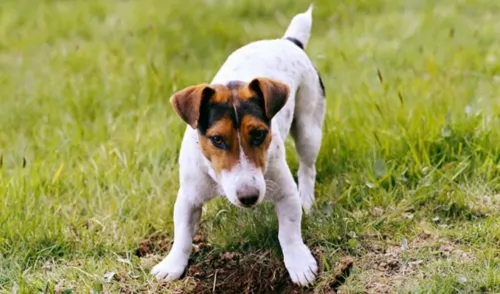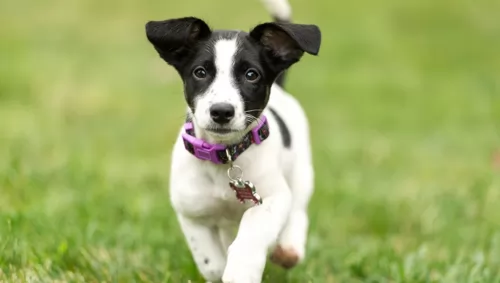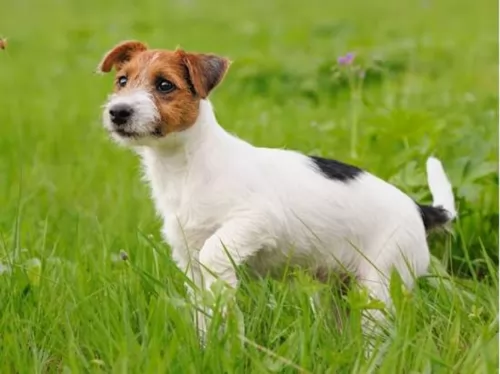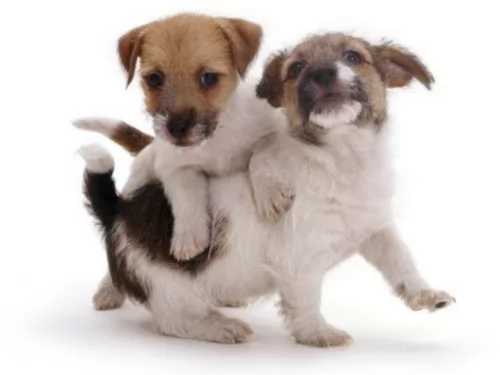 Petzlover
Petzlover Chinese Shar Pei is originated from China but Russell Terrier is originated from United Kingdom. Chinese Shar Pei may grow 21 cm / 9 inches higher than Russell Terrier. Chinese Shar Pei may weigh 13 kg / 29 pounds more than Russell Terrier. Chinese Shar Pei may live 3 years less than Russell Terrier. Both Chinese Shar Pei and Russell Terrier has almost same litter size. Chinese Shar Pei requires Moderate Maintenance. But Russell Terrier requires Low Maintenance
Chinese Shar Pei is originated from China but Russell Terrier is originated from United Kingdom. Chinese Shar Pei may grow 21 cm / 9 inches higher than Russell Terrier. Chinese Shar Pei may weigh 13 kg / 29 pounds more than Russell Terrier. Chinese Shar Pei may live 3 years less than Russell Terrier. Both Chinese Shar Pei and Russell Terrier has almost same litter size. Chinese Shar Pei requires Moderate Maintenance. But Russell Terrier requires Low Maintenance
 The Chinese Shar-Pei is originally from Canton, China. The Shar-Pei has a blue-black tongue and many deep wrinkles. They have more wrinkles as a puppy than the adult dogs do. They are one of the rarest breeds in the world and are considered a basal breed – meaning their existence predates modern canines. Most canines are related to the gray wolf through genetic admixture. However, there are breeds like the Siberian Husky, the Greenland Dog, Finnish Spitz and the Shar Pei are all related to the Taymyr Wolk of North Asia through admixture. The Shar Pei is found throughout the centuries in Chinese artwork, especially found during the Han Dynasty, and are considered one of the most ancient of breeds on earth today. In this period, they were fighting dogs then became beloved pets. Today the Tibetans still use them as fighting dogs.
The Chinese Shar-Pei is originally from Canton, China. The Shar-Pei has a blue-black tongue and many deep wrinkles. They have more wrinkles as a puppy than the adult dogs do. They are one of the rarest breeds in the world and are considered a basal breed – meaning their existence predates modern canines. Most canines are related to the gray wolf through genetic admixture. However, there are breeds like the Siberian Husky, the Greenland Dog, Finnish Spitz and the Shar Pei are all related to the Taymyr Wolk of North Asia through admixture. The Shar Pei is found throughout the centuries in Chinese artwork, especially found during the Han Dynasty, and are considered one of the most ancient of breeds on earth today. In this period, they were fighting dogs then became beloved pets. Today the Tibetans still use them as fighting dogs.
Following the Communist Revolution, the Char Pei was almost extinct until Margo Law saved the breed. During this time, they smuggled around 200 dogs into the United States. All the dogs in the United States today come from those 200 dogs. They were accepted in 1992 into the AKC. The dogs served as trackers, hunters, ratters, guard dogs and herders.
 This feisty little dog was developed in England a couple of centuries ago. He has a well documented history. An interesting aspect with this dog is that the very name ‘Jack Russell’ became a common name for predominantly white terriers after the death of clergyman Jack Russell.
This feisty little dog was developed in England a couple of centuries ago. He has a well documented history. An interesting aspect with this dog is that the very name ‘Jack Russell’ became a common name for predominantly white terriers after the death of clergyman Jack Russell.
The Russell Terrier was developed from Jack Russell working terrier strains that were used in the 19th century for hunting fox. The dog has been standardized by Kennel Club recognition. The Fedédération Cynologique Internationale also recognizes the breed.
It was in the early 1970s that the Jack Russell Terrier Club of Great Britain was formed.
 The Chines Sar Pei has what if known as a Horse-coat which is prickly, harsh, and rough to the touch on one direction and rough to touch on the other. Western Shar Peis can be Horse, Bearcoat and Brush. The Brush is longer and smoother while the Bear coat is rare and in-between the two. The Bearcoat is not accepted by the AKC while the other two types of coats are.
The Chines Sar Pei has what if known as a Horse-coat which is prickly, harsh, and rough to the touch on one direction and rough to touch on the other. Western Shar Peis can be Horse, Bearcoat and Brush. The Brush is longer and smoother while the Bear coat is rare and in-between the two. The Bearcoat is not accepted by the AKC while the other two types of coats are.
The Shar Pei should have a hippo shaped head, a black-purple tongue, black mouth, deep set almond shaped dark eyes, small ears and red coats. His profile is square, and his muzzle is full and wide. Most Shar Peis only have facial and neck wrinkles left as adults.
 The Russell Terrier has a weatherproof coat that is mainly white with patches of tan or black or maybe even both. You get the smooth haired type, the broken type- as well as the rough haired Russell Terrier. All these coats shed.
The Russell Terrier has a weatherproof coat that is mainly white with patches of tan or black or maybe even both. You get the smooth haired type, the broken type- as well as the rough haired Russell Terrier. All these coats shed.
He is a small dog standing at between 20-35cm in height and weighing between 7 and 12kg.
Your Russell Terrier is a jaunty, fearless, confident little dog with a powerful personality. The bright face with alert eyes are constantly telling you that he is just ready to spring into action when you’re ready.
He just loves games and sports and you won’t have to ask him twice to join in. Happy and energetic, you could say it's his desire to hunt as well as his high energy levels that make it necessary for him to be trained and socialized It is of particular importance because he is so strong willed. Super smart, you won't have any trouble teaching him some basic commands.
He also makes a good watch dog and while he can be aggressive towards other dogs, he is prepared to get along with children in the house who have been disciplined and who know how to treat animals with respect and kindness.
 The Shar Pei must be socialized early to other people, children and animals if he is to be friendly with them. He is loyal to his people and instinctively wary of strangers. He will be completed devoted to his people, but he is reserved and independent. They can be aggressive and territorial if not socialized. They are stubborn, loving and loyal. They are dominant, brave and playful. They are great watch dogs. Keep them busy because they tend to think a lot independently and if they don’t have a job they may create one.
The Shar Pei must be socialized early to other people, children and animals if he is to be friendly with them. He is loyal to his people and instinctively wary of strangers. He will be completed devoted to his people, but he is reserved and independent. They can be aggressive and territorial if not socialized. They are stubborn, loving and loyal. They are dominant, brave and playful. They are great watch dogs. Keep them busy because they tend to think a lot independently and if they don’t have a job they may create one.
 It is true that this very active, very 'in-your-face' dog may not be everybody’s cup of tea. He will be discontent if not given the chance to run and be active.
It is true that this very active, very 'in-your-face' dog may not be everybody’s cup of tea. He will be discontent if not given the chance to run and be active.
If you’re a super active family who loves swimming, going on hikes or you enjoy sports such as cycling and horse riding, you can count the Russell Terrier in every time.
These dogs make a loving, loyal companion. They'll make you smile and be amused by their antics, bringing you lots of joy and entertainment.
 Because of the rushed and inexperienced breeding programs in the United States due to the popularity of the breed, there are many health issues in the North American version of the Shar Pei. Their life expectancy is generally under ten years. They are prone to:
Because of the rushed and inexperienced breeding programs in the United States due to the popularity of the breed, there are many health issues in the North American version of the Shar Pei. Their life expectancy is generally under ten years. They are prone to:
 The Russell Terrier is a robust little dog who can lead a good, healthy life of 13, 14 or 15 years if well cared for. There are however, a number of common dog ailments that he can succumb to. Some of these are cataracts, deafness and myasthenia gravis.
The Russell Terrier is a robust little dog who can lead a good, healthy life of 13, 14 or 15 years if well cared for. There are however, a number of common dog ailments that he can succumb to. Some of these are cataracts, deafness and myasthenia gravis.
This disorder is caused by a breakdown of the transmission of impulses from the nerves to the muscles. The muscles can’t contract and the dog becomes weak. It’s a disease that can be an inherited congenital defect, and the Russell Terrier is at risk of getting this disease. Symptoms do vary from dog to dog but a common symptom is muscle weakness.
 Feed a good quality dry dog food but do not overfeed. You should feed twice a day about one cup per six pounds for puppies. Adults should have two cups a day.
Feed a good quality dry dog food but do not overfeed. You should feed twice a day about one cup per six pounds for puppies. Adults should have two cups a day.
• Familial Shar Pei Fever – congenital and serious. This produces fevers that can last from 24 hours to three days. Swelling around the ankles is due to fluid retention.
• Entropion eye issues – eyelashes curl in and inflame the eye. Can cause blindness if not treated. Requires surgery.
Both as a puppy and an adult this is a pretty active dog. He needs at the very least to be walked every day or have a back yard to play in. They are sensitive to heat so bring them in when its really hot and don’t walk them in the heat. They love to play, are athletic and competitive. Try agility, tracking, rally and obedience trials.
 This little dog needs plenty of exercise, and being lazy yourself and not exercising him will lead to him becoming destructive through no fault of his.
This little dog needs plenty of exercise, and being lazy yourself and not exercising him will lead to him becoming destructive through no fault of his.
He will need walks every day as well as runs in the park off his leash. Ball- and frisbee games fill him with delight and he gives chase every time. Even though he is small, he isn’t recommended for life in the city and small properties as he is a small dog with high energy needs and requires a lot of room to run.
The weatherproof coat isn’t going to require much grooming apart from a brushing twice week. Regular checking of the teeth, checking the eyes, looking inside the ears and checking for lumps will be required. He will also need to have his nails trimmed.
Provide him with nice, warm, dry place to sleep.
Have him neutered or spayed if you aren’t wanting puppies.
Keep his vaccines up to date and get him to a vet if you see his is lethargic, miserable and in pain.
Provide him with top quality food, whether it is commercially manufactured food or homemade food.
Your Russell Terrier will be relying on you for good food. Try to include some home-made food for him which can be simply mixed into the kibble twice a week which is easy to prepare and totally uncomplicated.
You can add everything together in one big pot -chicken, brown rice or pasta and spinach, sweet potatoes and carrots. This food can all be chopped up, refrigerated and added warmed up and in small portions to your pets dry kibble once or twice a week.
Simple and tasty, your Russell Terrier will love tasty treats like this. Ensure he always has a bowl of fresh, cool water within his reach.